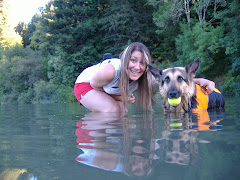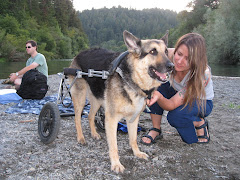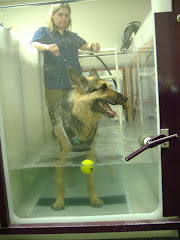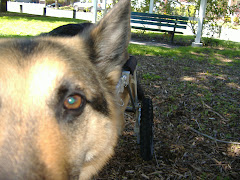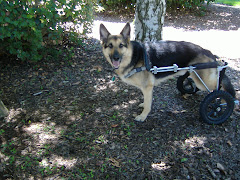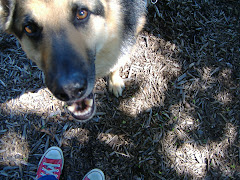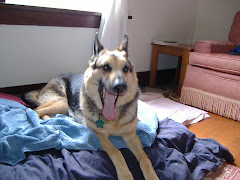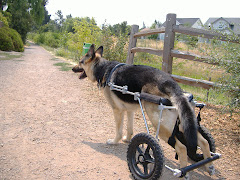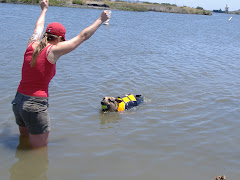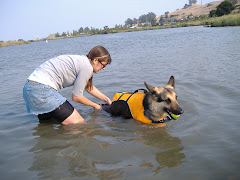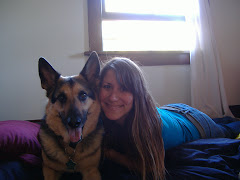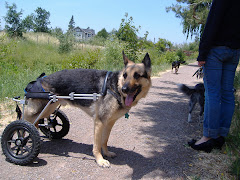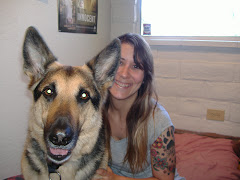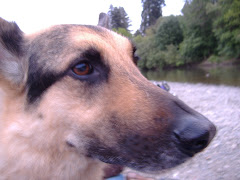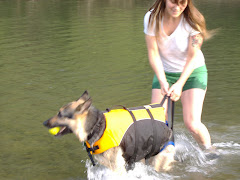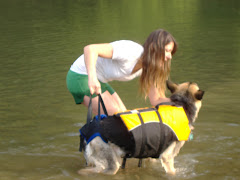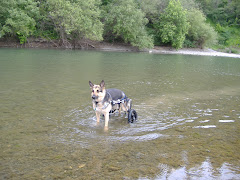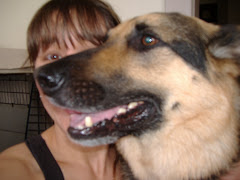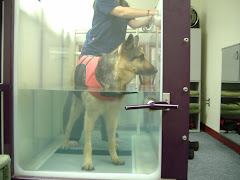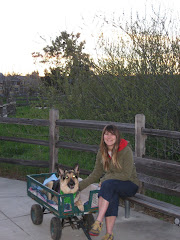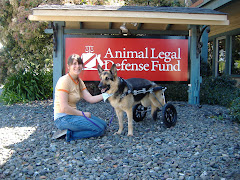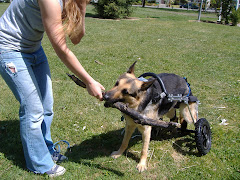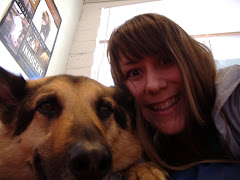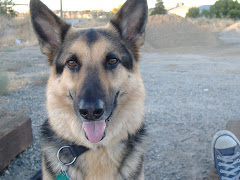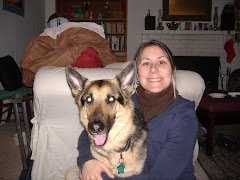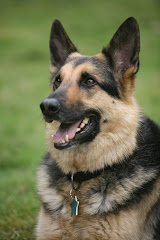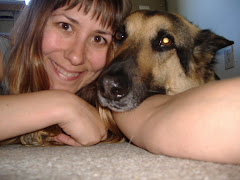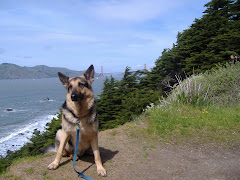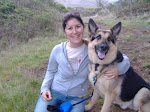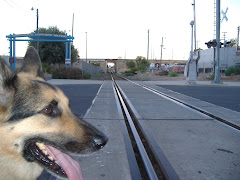A happy and relaxed Alec in the treatment room at West Hills Animal Hospital in Corvallis, Ore. Note the physio-rolls and rocker board; both are standard equipment used in canine rehab therapy.
I am happy to report that our visit to the West Hills Animal Hospital last week was a success! Alec and I both loved Dr. Moore. I found her to be very knowledgeable and thorough, while Alec was quite comfortable in her presence. She has a wonderful “bedside manner,” which I have learned is not something to be taken for granted. Alec is sensitive and anxious, but can be made calm relatively easily by the right person.
A case in point of a very bad experience I had in this regard was one of the facilities here in Portland to which I took Alec upon moving here over a year ago. The doctor and vet tech were demonstrating to me how to apply the “soft paws” nail caps, which help prevent dogs who drag their paws from ripping their toe nails. Well, Alec (like many dogs) does not like being compelled to lie on his side, and hates being restrained even more. I warned her of this fact. Yet to apply the nail caps, they held him down -- the doctor on one end of Alec, the tech on the other -- basically bear-hugging him with a vice grip to get him to hold still. Of course, this had the opposite effect and made him frantic; he began to thrash and whine and struggled mightily to get up. This made me uncomfortable, but I didn’t want to be “that client” – you know, the annoying person who tells the doctor how to do things. However, I feel I have become a good advocate for Alec without being an obnoxiously squeaky wheel. I voiced concern (“should you be holding him down like that with his back injury?”) and the doctor said, “He is just trying to see what he can get away with.” Well, be that as it may, he also had multiple spinal surgeries eight months before and I was told by his surgeon and rehab therapists to be careful of his back! And here they are restraining him with a full nelson (half nelson? – I don’t know anything about wrestling, but they were pinning him down) while he thrashed and flailed. Finally, I could not take it anymore and said, “That’s enough. I am not comfortable with this, please let him up.” Which they did, but they were clearly internally rolling their eyes at me. The doctor admonished me: “You baby him.”
I did not think this was fair. I know a good amount about dog behavior, and I know "bad" behaviors should not be reinforced. However, this particular dog has sustained a serious injury to his spine. Furthermore, it should be a positive experience for him to come to any rehab facility, which should factor into how he is treated. Maybe he should be “babied” a little so he wants to come back and do therapy...you can’t force a dog to do rehab exercises, and a little positive reinforcement could go a long way. It seemed this was definitely getting off on the wrong paw with Alec – not to mention with me. This was our first visit and she was not earning my trust with her rough handling of Alec. Veterinary "bedside manner" involves handling the human client as much as the canine patient, and I can sympathize with vets who have to deal with difficult clients on a regular basis. I strive to be pleasant and understanding in my interactions with veterinary personnel; I truly appreciate them and I want them to like Alec and me. But I think my concerns about Alec's back injury were reasonable and should have been respected rather than dismissed.
Afterward, I shared my misgivings about the experience with J., our trusted former rehab therapist back in Calif. (whom I was missing very much at that point!), and she was appalled that they would hold Alec down like that given his surgical history. And J. was always a proponent of rehab therapy being a positive experience for the dog. I didn’t realize this was not an attitude shared by everyone in the canine rehabilitation community. I did return to this facility a few times, trying to keep an open mind (I knew I missed our people in Calif. and realized this could be coloring my experience), but that was not the only negative experience I had, and I finally stopped taking Alec there. It’s unfortunate because, as I mentioned, they are conveniently located right here in Portland! Interestingly, I have not heard any negative feedback about this place from others, and I really wish my experience had been better. But I have to trust my intuition when it comes to Alec and what is best for him.
This happened over a year ago, but it serves as a counter example to illustrate part of the reason I liked Dr. Moore so much. Alec had to lie on his side at one point during the evaluation so she could check his reflexes. I found myself involuntarily tensing up, knowing how Alec would react if they wanted to hold him down. I cautioned he did not like lying down/being restrained and briefly relayed my experience at “the other place” and how Alec only became more frantic. Dr. Moore’s response? “I find belly rubs are more effective.” Ding ding ding! Correct answer. We both rubbed his belly and asked Alec to “stay,” and it was 100% more effective than forcibly holding him down. He was such a good boy (sure, he tried to pop up a few times, but it was nothing like his panicked thrashing at “the other place”). By the end of the appointment, nervous whiny Alec was so relaxed he was resting his head on Dr. Moore’s leg. It was remarkable. I should mention Trina, the lead vet tech who is also certified in canine rehab, was wonderful as well. I was so impressed with both of them, not to mention the clinic itself; even the front desk staff was incredibly friendly and helpful. Why is this place not closer to Portland??
Because Alec’s overall experience was very positive, he will be happy to go back again, which is good because we are driving back down to Corvallis every day this week to try the two new treatments Dr. Moore had mentioned on the phone: cold laser therapy and VOM (veterinary orthopedic manipulation). I meant to write an update about that but got stuck on bedside manner. I guess I didn’t realize how important it was – and how variable – until this positive experience! I think it is something we as human patients can relate to as well: sometimes feeling intimidated by a doctor but not knowing if you should speak up. I have learned to do this for Alec, but it is a tricky balance between asking questions and not offending anyone. Although I have found a good vet will welcome questions and appreciate the fact that, as the person who lives with and observes your dog closely all the time, you are a crucial member of the veterinary team. This is part of the reason I am so happy with our current regular vet here in Portland. She is very patient with my questions (and I ask a lot of questions!) and thorough with her answers. She realizes a caregiver who is engaged and paying attention will make the veterinarian’s job easier.
This reminds me: I am reading a good book right now on this subject called: “Speaking for Spot: Be the Advocate Your Dog Needs to Live a Happy, Healthy Longer Life.” Coincidentally, the author, Dr. Nancy Kay, practices at the Animal Care Center in Sonoma County where Alec had his spinal surgeries, although she never treated Alec and I have never met her. The book, which was published in 2008, is great primer on all things related to being an effective medical advocate for your dog: asking the right questions, finding a vet and clinic you and your dog will love, knowing when to get a second opinion, making your vet appointments less stressful, etc.
Anyway, I will write more soon, but basically Dr. Moore had lots of ideas for new things to try with Alec. She confirmed that his lingering limp is due to a proprioceptive (neurological) deficit, and that the muscles in his right back leg are weakened/moderately atrophied due to his abnormal gait. However, she said he had excellent flexibility and range of motion, which means muscle shortness is not an issue. So she suggested some strengthening exercises I could do at home for the weakness and she thought Alec would be a good candidate for the two modalities mentioned above: cold laser therapy and VOM (veterinary orthopedic manipulation). The catch being that the laser therapy has to be done twice a day (1½ hours apart) for the first three days, then once a day for the next three days, and then every other day, and so on, until it gradually tapers off. The good news is she said we will know by the end of the week if it is working. If we don’t see any improvement by then I will discontinue the therapy. The basic idea behind VOM is it is supposed to open up blocked neural pathways, making it a good modality for dogs with neurological issues. The cold laser stimulates blood flow and aids in nerve regeneration as well, so these two therapies should theoretically complement each other.
So, I took the whole week off work (thank goodness I have saved my vacation days!) and we are making the hour and half trip down to Corvallis every day for the treatments. Speaking of which, we have to hit the road for day 3…more soon!
Wednesday, February 17, 2010
On Bedside Manner
Sunday, February 7, 2010
Two Year Update: Plateau or No?
It has been two years since Alec became paralyzed after a disc shattered in his back, severely damaging his spinal cord. He underwent a multi-level hemilaminectomy (decompressive surgery) on February 9, 2008 and a second hemilaminectomy four days later on Feb. 13. He came out of the second surgery with no use of his hind limbs, no conscious control of his bowels, and no bladder function at all. Things looked bleak indeed, and when Alec presented for his first re-check exam with the neurologist six weeks later, he was given a poor prognosis for return to normal function, based on the fact that his deep pain perception had not returned. I began rehabilitative therapy with him, just in case, and ordered him a mobility cart (doggie wheelchair), which he used for 18 months. If you have been reading this blog, you know that Alec began to walk on his own about a year later (short walks around the block at first), and six months after that, he stopped using his doggie wheelchair altogether.
As I have written in other posts, the most important factors in Alec’s amazing recovery were: 1) regular physical therapy, and 2) time. Less quantifiable, but also instrumental, were my faith in Alec, and my boundless love for him. It has been an incredible two years, difficult and inspiring, confounding and rewarding. Because our wonderful rehab therapist in California, J., impressed upon me the importance of consistent physical therapy (to give him any chance at all to recover some mobility, as well as to preserve what he had left), I followed her advice very closely. It was a formidable challenge, but we persisted, Alec and I together, and it paid off big time; despite the scary hard times in the beginning, I feel like I won the lottery. Alec has been walking outside his cart for eight months now. His left hind leg is perfect as far as I can tell; his right leg lags, however, and cannot make a complete rotation. The result is he has an abnormal gait, or in layperson's terms: he has a pretty serious limp. It does not cause him pain, and he gets around exceptionallyreally well, but he has to wear a protective shoe on walks. Without a shoe, his foot will became scraped because his paw drags slightly – just enough to tear it up except when he is on grass or another soft surface (he does not have to wear the shoe inside). To complicate matters, his abnormal shuffle-step causes whatever shoe I try to wear out quickly; duct tape and shoe goo have become my allies in the battle against the deteriorating shoe. But neither holds up very well to the toe dragging. This small complication aside, Alec arrives at the two-year mile marker having exceeded all expectations.
After all of these improbable improvements, including what seemed like the pinnacle of Alec’s protracted process of rehabilitation (ditching the cart completely – hallelujah!), at some point during the last six months, I noticed he seemed to have finally reached a plateau. This awareness came slowly. I am with Alec almost 24-7 and even his slight improvements sometimes were noticed by other people before me. It’s like when you live with someone and don’t notice the small physical changes, like a gradual weight gain. Often people will point out to me, “wow, he is getting around so much better than last time I saw him!” – that type of thing. People do still say that, but at some point, I stopped noticing measurable improvements in his mobility (as opposed to his endurance, which we have been working on with faster UWTM sessions and longer walks).
Not that this ostensible plateau bothered me – not at all. Alec had already come farther than anyone had expected, and even when it became apparent after eight months he might be able to walk again on his own, I was told his recovery would very likely not be complete. He may just regain enough ability to walk outside on his own to go to the bathroom and then come back inside, for example. So the fact that he is enjoying hour-long strolls in the park is nothing short of amazing to me! I always knew the improvements would stop. The suspenseful part was when? How well would Alec be doing when he hit that inevitable plateau? The answer, for which I am profoundly grateful, is very well indeed. Limp, schmimp…my boy is walking!
But what if a plateau is...not a plateau? Recently I was emailing with J., our former rehab therapist, giving her an update on Alec and asking her advice about whether she thought I should continue doing the UWTM with him every week now that he was walking on his own and had reached this plateau. Did she think I should concentrate on swimming instead? To my surprise, J. wrote: “I have seen dogs continue to progress 2-3 years out. I would not be surprised if Ali does the same. I don’t think his plateau is permanent.” Huh! I stared at my computer screen in wonderment. This had not occurred to me. I know the scant literature advises the majority of dogs will improve the most during the six months after surgery, but this was not the case with Alec. He continued to show significant improvements way past that marker. Was it possible he had more potential...even after two years? I had to find out.
So after doing some research on rehab vets in Oregon within driving distance, I decided to take Alec to a new specialist, Dr. Julia Moore of the West Hills Animal Hospital in Corvallis (an hour and half drive south of Portland). Alec has been to both rehab veterinarians in Portland, and I thought at this point it would be good to have him evaluated by someone who has never seen him before, someone who will look at him with fresh eyes. I called the clinic last week to ask if it made sense to bring Alec in for an evaluation, given that he is two years out of surgery. Dr. Moore called me to discuss Alec’s situation the next day and I was impressed with her on the phone. I explained that my goal is to learn whether Alec has potential to further improve (and if so, what can I be doing to help him reach his potential?), or if my focus with physical therapy should be maintenance at this point. I have no problem with the latter, but if there is something more I could be doing to help him improve – new rehab exercises or modifications to our routine – I want to make sure I am doing it and not giving up too soon!
We spoke for twenty minutes and she is clearly very experienced in this area. I got the impression she would have a lot to offer by seeing Alec. She also mentioned they are using a relatively new technique called cold laser therapy, for which Alec could be a candidate, and that he could potentially be helped by a modality called veterinary osteopathic manipulation (or VOM). She said she has seen incredible results with these therapies. I am pretty sure laser therapy has been available at other places I have taken Alec, but no one has suggested it before, so it could be that he is not a good candidate; we'll see. I asked whether she had seen improvements in dogs who were two years out of surgery, and she had. She said the first step will be to determine whether Alec’s lingering limp is due to proprioception (position sense/awareness of foot placement), weakness, or muscle shortening, and that there are different things we could try based on which it is. After our conversation, I was very excited for her to see Alec.
They were able to schedule us tomorrow morning, so we will be leaving the house at 7am and braving the rush hour I-5 traffic to head south to Corvallis for our 9:15 appointment. Alec likes to ride in the car, and he will be excited for a new adventure, so no problem there. While I hope she evaluates him and has ideas for new things to try, if her opinion is that Alec has gone as far as he can go in his recovery, I will be happy with that, too. I just want to know whether my focus at this stage should be on maintenance or improvement. I'd hate to NOT be doing something I could be; if this plateau could be temporary, then I want to do everything I can to help him get over it! I don’t want to be greedy, but if Alec’s right hind leg could catch up to his left, and if his gait could further normalize, this would improve things in many ways. He would no longer be in so much danger of injuring his paw, and his body weight would be distributed more evenly. Right now, he still puts excess weight on his front end, which stresses those joints and is not ideal.
So, as incredibly well as Alec is doing at the two-year mark, and as through-the-roof-thankful as I am for every single improvement, if I could be doing something more for him, I want to know about it! This is still a new world to me, and I am continuing to learn. Please wish us luck tomorrow; I will post an update after our appointment. As always, thank you so very much for reading, and for caring.



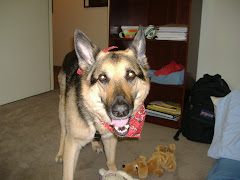


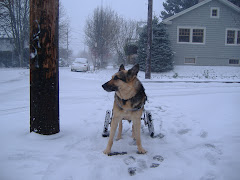
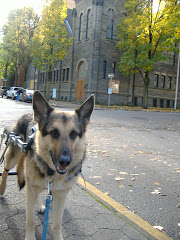
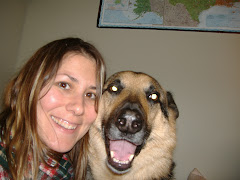
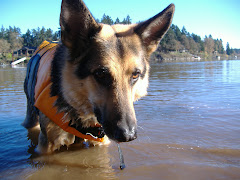
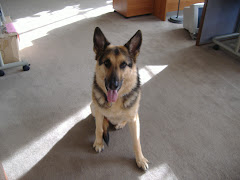
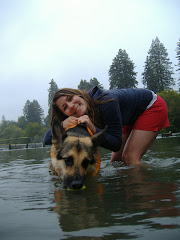_9_19_08+030.jpg)
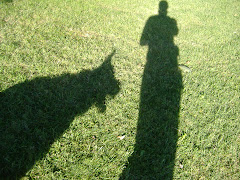
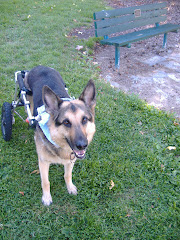
_9_19_08+045.jpg)
_9_19_08+001.jpg)
